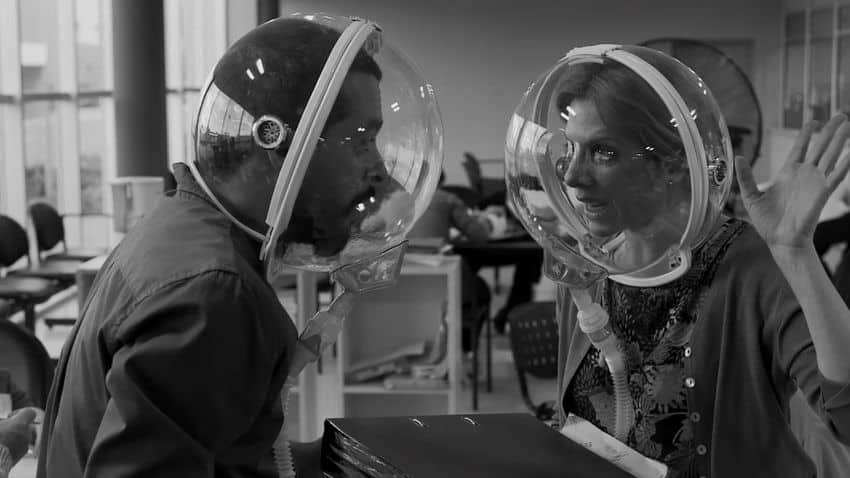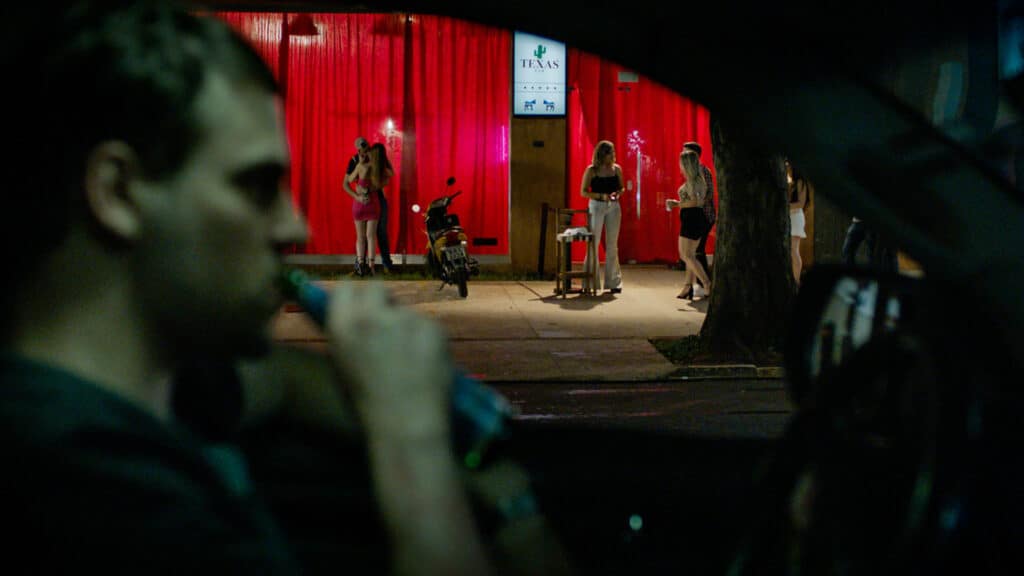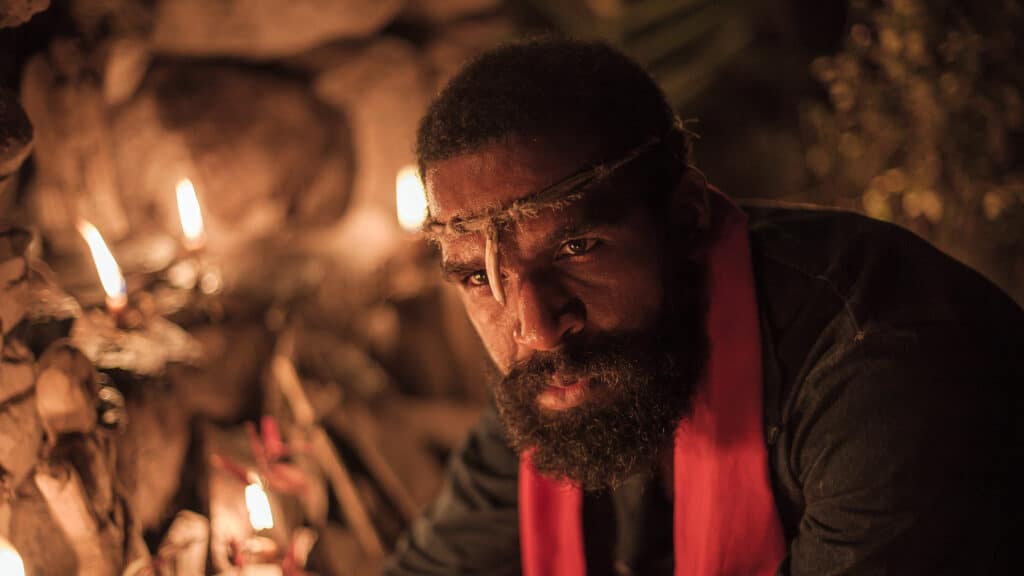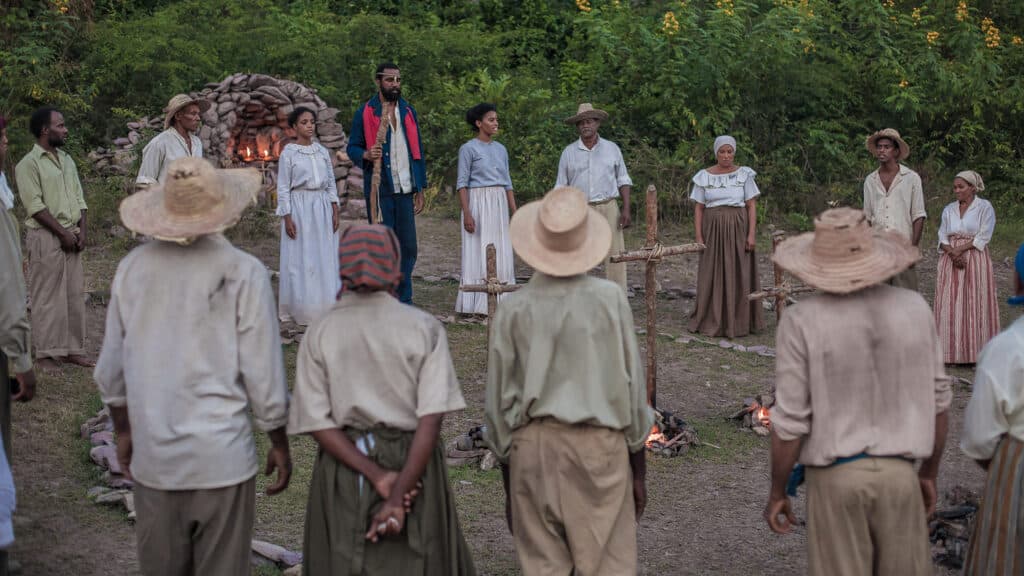Madalena is the debut feature of Madiano Marcheti. The film begins with several shots of landscapes that get increasingly cultivated. The way it’s shot, it takes on a character of its own. Eventually, we reach a soy field where the titular character lies dead. What follows is not an investigation of the case. In fact, there hardly seems to be any case or investigation of who killed the trans woman. Instead, the film is a triptych that follows some people who are connected with Madalena in one way or another.
First, we follow Luziane. She is a club hostess, and we see her knocking on Madalena’s door to get money. In the second segment, we meet Cristiano, whose father owns the soy fields. He wants to prove to him that he can inspect them. Bianca and her friends divide Madalena’s belongings and go for a picnic by a creek in the final segment.
Figures in a Landscape
The three segments are standalone, and no attempts are made to unify them narratively. They provide different aspects of the same event or non-event. Luziane shoots a commercial in the soy field, containing lyrics about a cowboy who labels himself a gladiator and claims that the bed is his arena. Cristiano spends his days drinking, body-building and injecting himself with hormones. He is haunted by Madalena’s found body, and even brings a friend there to watch it, but fails to locate it in the vast field. On the other hand, Bianca and her friends are only seen at Madalena’s home and in the forest.
The Green Desert
There is a stark contrast between the two settings. The cultivated landscape is flat and so vast that it’s overlooked by drones. The forest and the river where Bianca and her friends have their picnic feel serene in comparison. As mentioned above, the landscape could be seen as the fourth character of the story. The scenes by the soy fields and their pesticide sprayer are shot in a formal fashion that, in some ways, echoes Antonioni. That is also true of the nightly sequence when Cristiano wants to find the body that resembles Blow-Up (1966). The location of the picnic functions as a safe space for Bianca, who is also a trans woman.
Brazil has the world’s highest murder rate of transgender persons. Choosing an unusual form for such a sensitive and emotional topic serves the film well. The director, who skillfully handles the contrast between the agribusiness and the untouched landscape, comes from the region where the film is set, called Mato Grosso do Sul. He has still found a form that has a formal rigour, without being too academic. As I mentioned in the text about Todos os Mortos, Brazil has been a prominent presence at festivals lately. Madalena is yet another strong example of the strength of Brazilian cinema.
Ana Katz is a name I remember from the film A Wandering Bride (Una Novia Errante 2007). This year, she returned with El Perro Que No Qualla. Sébastian (played by the director’s brother Daniel) has a dog who constantly barks when he works. His neighbours confront him and implore him to do something about it. When he tries to bring the dog to work, he is summoned to his superiors, who give ludicrous reasons why it’s impossible to bring the dog there. “If you bring a dog, other men might come to work wearing a dress or pole dance”. Subsequently, he quits and leads a life with no clear prospects, taking on odd jobs here and there.

The film cuts through time abruptly without unnecessary explanations. It has a quirky quality with touches, like certain scenes being shown as simple animations. Some of them would simply be too expensive to stage. Others show moments that may be too strong. In the last section, there is an earth-shattering event that everyone has to adapt to. Sébastian never seems to react to anything that happens to him in life, and I had the same feeling while watching this short film. It’s not without its charm, but in the end, it’s too slight to really matter.
Liborio is the first film by Nino Martinez Sousa. It begins with a violent hurricane that forces Olivorio Mateo, called Liborio. to take shelter in a cave. Once there, we literally see him disappear in front of our eyes. In the village, he’s believed to be dead. Then, he suddenly reappears and starts acting like a prophet. He claims he has a mission: To bring the good and take away evil. He builds a commune, and people begin to congregate by his side. They move to the mountains in search of freedom. Liborio is an actual historical figure in the Dominican Republic, and the term Liborism still has value there. However, the film is not merely a story about him.
The structure of the work is quite distinct. It’s divided into seven chapters, where each one is seen from the viewpoint of different characters. The director states the intention like this.“The other” is constantly depicted with the shot from behind. The shot of the character without a face takes us to the very idea of character as a reflection of the self, the shadow that ties us to the collective unconscious”. Lofty ambitions for a debutant, but the execution of the ideas is impressive. Aided by Oscar Duran’s lensing and the brilliant sound design by Maite Rivera Carbonell, Sousa’s achievement has been compared to Martel’s Zama (2017).
Even if it doesn’t reach the heights of Martel’s masterpiece, the experience is a strong one. Personally, I was constantly thinking about Miklós Jancsó in the way a commune is depicted with formalistic rigour. Liborio is somewhat difficult to describe, and the film may warrant multiple viewings, but it’s a marvellous, immersive experience. Once again, the Rotterdam Film Festival showcases an impressive selection, especially when it comes to debutants.





